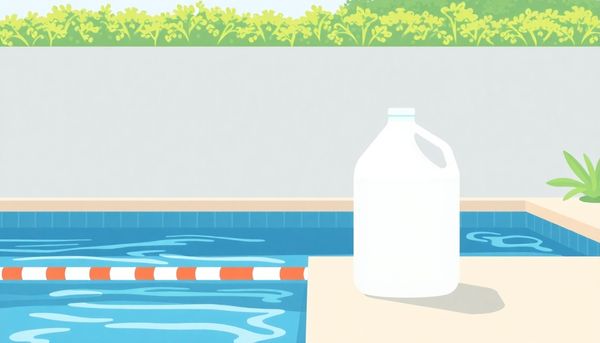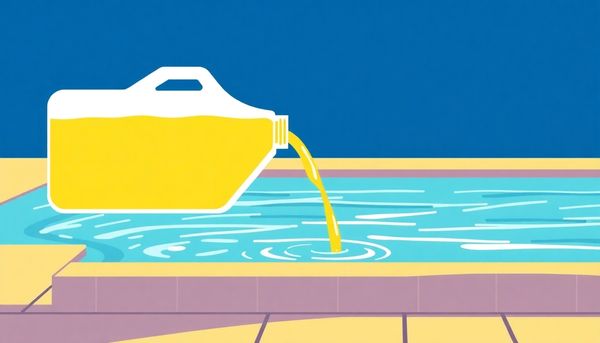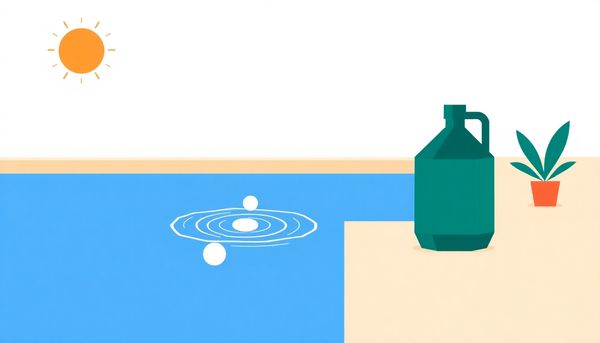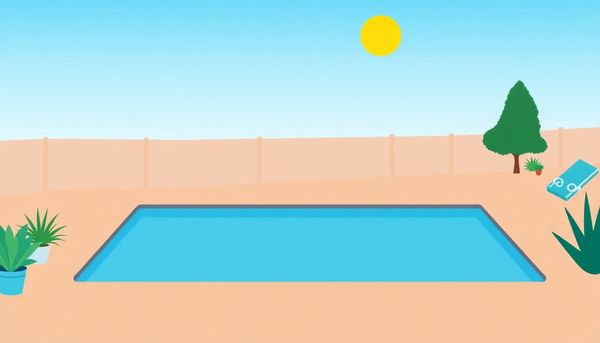Master Pool Shocking: Keep Your Water Crystal Clear and Safe
April 26th, 2024
April 26th, 2024
On a sweltering summer afternoon, the shimmering surface of a pool promises a refreshing escape. But, as any pool owner knows, that inviting blue water requires more than just skimming off leaves or adjusting the chlorine levels. It involves a ritual known as "pool shocking," a crucial step for maintaining water that isn’t just clear but also safe. Knowing how to properly shock a pool can transform your backyard haven into a truly pristine oasis, free from unwanted bacteria and algae.
Recalling my own experience, I learned the importance of this process one particularly humid July day. After noticing a slight cloudiness despite regular maintenance, I realized that my pool needed a deeper cleanse. Pool shocking involves adding a concentrated dose of chlorine or non-chlorine oxidizer to eliminate contaminants, and it's not just a simple toss-and-forget procedure. It requires understanding water chemistry and the types and amounts of chemicals that suit your pool's needs.
Every pool is unique, with its own quirks and demands. Factors such as sunlight exposure, frequency of use, and even recent weather changes all play a role in how often and intensely you need to shock your pool. By mastering this process, you’re not just maintaining a pool; you’re ensuring a safe, enjoyable swimming experience for family and friends, keeping the waters inviting and healthful throughout the season.

Understanding the art of pool shocking can transform your maintenance routine from a chore into a seamless ritual. One summer evening, as I stood by my own pool, I noticed a faint, unsettling odor—a telltale sign of chloramines lurking beneath the surface. This experience marked the beginning of my journey into mastering pool-shocking techniques. Chloramines, those pesky byproducts of chlorine doing battle with impurities, can often sneak up on pool owners, clouding the water and pinching the nose with their pungent aroma.
Timing is crucial when shocking your pool. As the sun dips below the horizon, it’s time to act. UV rays can degrade chlorine, wasting your efforts. By waiting until night, you ensure the chemicals work with maximum efficiency. With a variety of products available, from calcium hypochlorite to non-chlorine alternatives like potassium peroxymonosulfate, choose the one that suits your pool’s specific needs. Each has its benefits, whether it’s the quick dissolve of lithium hypochlorite or the safe, fast-acting nature of non-chlorine shock.
Precision also plays a role. Ensure your pool’s pump and filter are running full throttle to distribute the shock evenly. After adding the shock, let the system run for 8-12 hours to ensure thorough mixing. By following these steps, you not only keep your pool sparkling but also create a healthier swimming environment, free from the grip of unwanted contaminants.
Battling algae in your pool often feels like an uphill struggle. Just when you think you've won, a stubborn patch reappears, mocking your efforts. An effective strategy to keep these pesky invaders at bay is regular pool shocking—a process that not only zaps algae but also ensures your pool water remains pristine and odor-free. A friend once invited me over for a swim, and as I sat on the edge, I couldn't help but notice the slight green tinge in the corners. It reminded me of the importance of consistent maintenance.
Each time you shock your pool, you're giving it a deep clean. By introducing a high dose of chlorine, or a suitable alternative, the process breaks down chloramines. These are the culprits behind that strong chlorine scent and cloudy water. It's like hitting a reset button, ensuring that your pool is free from contaminants that could allow algae to thrive. Regular shocking can be likened to flossing your teeth—while it might not seem urgent at first glance, neglecting it can lead to bigger issues down the line.
To get the best results, timing is key. Choose to shock your pool in the evening, when the sun's rays won't interfere with the chemicals. And remember, consistency is paramount. Shocking your pool weekly or biweekly, depending on usage and weather conditions, guarantees a clean and inviting pool that’s always ready for a refreshing dip.
Selecting the right shock product for your pool is akin to choosing the perfect tool for a job—each one has its strengths and specific applications. With a variety of options available, understanding their unique features ensures your pool remains an inviting oasis.
Calcium hypochlorite, affectionately known as cal hypo, is a staple in many pool owners’ arsenals. Its long-standing reputation for efficacy and affordability makes it a popular choice. However, if your pool water has high calcium levels, you might want to consider lithium hypochlorite. Although a bit pricier and harder to find due to its lithium content, it dissolves quickly, making it an excellent option for fast results without pre-dissolving.
For those seeking a more user-friendly approach, dichlor shock might be your best bet. Its stabilized nature means it can be added to your pool directly, making it ideal for both regular and saltwater pools. Moreover, it contains cyanuric acid, which helps protect chlorine from UV degradation, ensuring your pool stays sanitized for longer.
If a non-chlorine option is more appealing, potassium peroxymonosulfate fits the bill. This type of shock works rapidly, allowing for a quicker return to swimming, and is perfect for those spur-of-the-moment pool parties. This option is particularly favored in saltwater pools, preventing the buildup of chloramines without significantly affecting chemical levels.
Choosing wisely means giving your pool the best care it deserves, keeping it clear, clean, and ready for any splash-filled adventure.
Saltwater pools might conjure images of ocean-like breezes and gentle waves, but maintaining their clarity requires more than just a dream of seaside serenity. It's essential to know that saltwater pools are, in essence, chlorine pools. The salt simply transforms into chlorine via a generator, meaning regular shocking remains crucial. A unique aspect of saltwater pools is their compatibility with non-chlorine shock treatments, like potassium peroxymonosulfate, which quickly oxidizes organic contaminants without the harshness of chlorine. This is especially beneficial for those with sensitive skin or eyes.
In my experience, choosing the right shock for your saltwater pool can make all the difference. I've found that dichlor, a dichloroisocyanuric acid-based shock, strikes a balance by providing effective sanitation while maintaining cyanuric acid levels. This stability is vital to protect your pool's chlorine from being zapped by the sun's UV rays. Moreover, the convenience of using the pool shortly after non-chlorine treatments is a luxury few pool owners overlook, especially during a busy summer weekend.
Remember, even though saltwater systems offer the convenience of automatic chlorine generation, they still benefit from regular checks and balances. Consider hitting the "super chlorinate" button on your generator after heavy use or rainstorms to mimic a shock treatment. This not only boosts chlorine production but also ensures that your saltwater pool remains a haven of crystal-clear waters and relaxed enjoyment.

When it comes to maintaining a pristine pool, algae can quickly become an unwelcome guest. A single bloom can transform your sparkling oasis into an unsightly green swamp. However, a strategic dose of pool shock can effectively combat this persistent invader. My cousin once faced a similar dilemma. A weekend getaway turned her pool into an algae playground. The remedy? A well-timed shock treatment that brought the water back to life.
Shocking your pool involves introducing a high concentration of chlorine, capable of obliterating algae and maintaining the health of your water. This process is akin to giving your pool a deep cleanse, ensuring that chloramines—those pesky compounds formed when chlorine reacts with organic waste—are broken down. Not only does this enhance the pool’s hygiene, but it also eliminates the unpleasant odor associated with chloramines. Without these measures, you might find yourself replacing your pool water more often than enjoying it.
Remember, timing is crucial. Conduct shocking sessions after sunset to avoid the sun’s UV rays from reducing the effectiveness of the chlorine. This ensures the chemicals work their magic undisturbed. For those who swim regularly or have high usage, consider weekly shocks as a preventive measure. This routine not only keeps algae at bay but also maintains balanced water chemistry, allowing you to dive into crystal-clear waters anytime you please.
Keeping pool water pristine goes beyond just the routine vacuuming or skimming. Regular pool shocking is akin to hitting the reset button for your pool's sanitary conditions. Imagine it's mid-summer, you're hosting a pool party, and children are cannonballing into crystal-clear water. Behind that scene of fun and refreshment is a regimen of regular pool shocking.
Every time swimmers jump in, they introduce body oils, sweat, and sometimes less savory contaminants that combine with chlorine to form chloramines. These chloramines are the culprits of that overpowering "chlorine" smell, a sign that your pool's water is struggling to stay clean. Shocking your pool weekly—or at the very least, every other week—ensures these chloramines don’t accumulate. By adding a concentrated dose of chlorine, you utterly destroy the chloramines and restore your water’s freshness.
You might remember a time when you stepped into a pool and noticed it was slightly cloudy or smelled odd. Chances are, it needed a shock. For those unfamiliar with the process, it may seem complex; however, with practice, it becomes second nature. Akin to changing the oil in a car, pool shocking is essential upkeep, preventing small issues from escalating into costly repairs. Embrace this routine, and enjoy a summer filled with nothing but pure, inviting water.
Choosing the right shock for your pool is akin to selecting the perfect ingredient for a recipe; it can make or break the outcome. Each type of pool shock is designed with specific roles in mind, and understanding these can save you from future headaches. Recall the time when your pool appeared murky, or the usual chlorine scent was unusually strong. These are signals of chloramine buildup or algae invasion, where pool shock acts as your secret weapon.
Consider calcium hypochlorite, the classic choice for many pool owners, offering a robust response to bacteria and algae. It's economical and effective, especially for pools with stable calcium levels. However, if your pool already has high calcium, lithium hypochlorite could be a superior alternative due to its fast-dissolving nature, though it comes at a higher cost and may be harder to find due to shifting lithium uses.
For those using saltwater systems or looking for a quick post-treatment swim, non-chlorine shock, like potassium peroxymonosulfate, offers a gentle yet effective clean without the chlorine-related downtime. Dichlor shock presents another versatile option, suitable for both saltwater and traditional pools, providing a balanced solution with the added benefit of stabilizing cyanuric acid.
Selecting the right shock isn't merely a task—it's a strategic move in maintaining your pool’s health. Each type has its merits, ensuring that your pool remains a haven rather than a hassle. Choose wisely, and your pool will reward you with sparkling clarity and a refreshing experience every time.
Creating the perfect pool environment isn't just about adding shock and hoping for the best. It’s an intricate dance of water chemistry that ensures your swimming haven remains pristine and inviting. I recall the first time I managed my own pool; I underestimated the importance of balanced chemistry, resulting in murky water that was anything but inviting.
To start, maintaining a pH level between 7.4 and 7.6 is crucial. This range ensures that your chlorine works effectively and keeps skin irritation at bay. I remember the frustration of having itchy eyes after a swim, only to discover my pH levels had been off. Regularly testing and adjusting these levels can prevent such discomfort.
Next, there’s alkalinity, which acts as a buffer for pH, preventing drastic changes. Keep it between 100 and 150 ppm. I learned this the hard way after a rainstorm threw my pool's balance into chaos. Regular testing saved me from a repeated mishap by catching fluctuations early.
Calcium hardness is another factor, especially vital for pools with concrete or plaster surfaces. Aim for 200 to 275 ppm to prevent etching or scaling on pool surfaces. Vinyl and fiberglass pools can have slightly lower levels. Consistent monitoring of these parameters not only enhances the effectiveness of shocking but also prolongs the life of your pool’s structure. With these in place, your pool remains a crystal-clear oasis, ready for endless enjoyment.

Balancing pool water chemistry is like fine-tuning a musical instrument. Each element, from pH to alkalinity, plays a vital role in creating harmony within your pool. Neglecting this balance can lead to murky water and unwanted algae—both of which can unravel your tranquil poolside oasis. To get it right, begin with regular water testing. It’s crucial to know your pH levels, which ideally should hover between 7.4 and 7.6. You don’t want the water to sting your eyes or corrode your pool equipment.
Next, pay attention to alkalinity, maintaining it between 100 and 150 parts per million (ppm). Alkalinity acts as a buffer, keeping pH fluctuations in check. While testing, don’t skip calcium hardness. For vinyl or fiberglass pools, aim for 175-225 ppm, and if you have a concrete pool, 200-275 ppm should do. This optimizes the structural integrity of your pool walls and floor.
A few summers back, after a family barbecue, I found the pool turning slightly cloudy. A quick check revealed imbalanced pH and alkalinity levels. Adjusting them before shocking the pool made a world of difference. This ensures that pool shock works effectively, clearing up cloudiness and preventing chloramines from creeping back in. Remember, a well-maintained chemical balance doesn’t just prevent issues—it keeps your pool inviting and safe for every swim.
Maintaining crystal-clear pool water is a swim enthusiast’s dream, and regular pool shocking is the unsung hero in achieving this goal. By routinely shocking your pool, you prevent algae and bacteria from digging in, safeguarding the water from turning into an unsightly green swamp. Remember that overwhelming chlorine smell from a neglected pool? That's not how clean pools should smell. Routine shocking eliminates chloramines, the culprits behind that nose-wrinkling odor, ensuring your pool remains a refreshing oasis.
Now, let’s talk frequency. For some, weekly shocks might seem excessive, but consider this: every splash, every bit of sunscreen, sweat, or accidental spill adds to the chemical load on your pool. If your pool sees frequent parties or heavy use, consider upping the ante with an additional shock session. This proactive approach acts like a vigilant guardian against water cloudiness and unwanted infestations.
A personal anecdote to illustrate the point: last summer, I let pool maintenance slide during a particularly busy week. The result? Cloudy water and a frantic Saturday spent restoring my pool’s former glory. Lesson learned. Scheduled shocks became as routine as mowing the lawn, and my pool stayed sparkling clear for the rest of the season. Regular shocking isn’t just about maintenance—it’s about enjoying peace of mind, knowing your backyard retreat remains inviting and pristine.
Selecting the right shock product for your pool isn't just a matter of convenience; it's the cornerstone of effective maintenance. Each option on the market serves a distinct purpose, ensuring your water remains crystal clear and safe for swimmers. Among the myriad choices, calcium hypochlorite, or cal hypo, stands out as a popular and cost-effective option. Having used it myself, I can attest to its ability to swiftly eradicate bacteria and algae, making it a staple in many pool care routines. However, if your pool is prone to high calcium content, you might consider lithium hypochlorite instead. Though pricier and harder to find due to lithium's demand in other industries, it dissolves rapidly, minimizing the risk of cloudiness.
For those concerned with saltwater systems, dichlor shock is often recommended. This is a stabilized chlorine product, ideal for pools that regularly battle harsh sunlight. With its cyanuric acid content, it’s a two-in-one solution protecting both water clarity and chlorine longevity. On the other hand, if immediate swimming is on the agenda, a non-chlorine shock is your best bet. Potassium peroxymonosulfate offers a swift, residual-free alternative, perfect for those spontaneous pool days.
Choosing the right product begins with understanding your pool's unique needs. Whether it's cal hypo for its affordability, lithium hypochlorite for its quick dissolution, or non-chlorine options for instant use, effective pool shock choices pave the way for a perpetually inviting swimming environment.
Balancing water chemistry in a pool is much like crafting the perfect recipe: every ingredient must be precisely measured and mixed to ensure the final product is as delightful as it is safe. When it comes to your pool, maintaining a harmonious balance of pH, alkalinity, and calcium hardness is key. Just last summer, my neighbor learned this the hard way when her pool turned an unappealing shade of green due to neglected chemical levels. She was shocked by how swiftly algae had taken over, underscoring the importance of vigilance in pool care.
To avoid such surprises, start by regularly testing your pool’s water. Check that your pH level hovers between 7.4 and 7.6 for optimal swimmer comfort and chlorine efficiency. Alkalinity acts as a buffer for pH, so aim to keep it between 100 and 150 parts per million (ppm). Meanwhile, calcium hardness should be adjusted depending on your pool’s materials: fiberglass and vinyl require between 175 and 225 ppm, whereas concrete pools need 200 to 275 ppm.
Incorporating these regular checks into your pool care routine will ensure that when you do shock your pool, the treatment is effective. Trust me, after helping my friend recalibrate her pool chemistry, we were both convinced that a little proactive maintenance can save countless headaches—and keep your pool inviting and crystal-clear.

When it comes to shocking your pool, choosing the right shock product is like selecting the perfect seasoning for a dish—crucial for getting that ideal balance. Each type of shock has its own strengths and best-use scenarios, and your choice often hinges on your pool’s specific needs.
Calcium hypochlorite, or cal hypo, is a staple for many pool owners. It's the go-to for budget-conscious individuals, offering a robust solution for killing bacteria and controlling algae. However, if your pool already has high calcium levels, this could add to the problem. On the other hand, lithium hypochlorite dissolves more quickly, a boon for those eager to swim soon after shocking. The downside? It’s pricier and harder to find due to the high demand for lithium in other industries.
For pools that require a gentler touch, especially saltwater ones, dichlor shock steps up. It’s user-friendly and contains cyanuric acid, which helps stabilize chlorine under the sun’s rays. If you want to avoid chlorine altogether, consider non-chlorine shock options like potassium peroxymonosulfate. This is a fast-acting alternative that maintains all the sanitizing power without the chlorine smell.
Personal experience has taught me the importance of selecting the right product. A friend once struggled with persistent algae because she continually chose the wrong shock. Once she switched to a non-chlorine alternative, her pool transformed almost overnight. So, take a moment to assess your pool’s unique characteristics and choose the shock that aligns best with your maintenance goals.
Choosing the right pool shock can feel like picking a dish from a menu written in another language—each option has its own peculiarities and best-use scenarios. Calcium hypochlorite, or cal hypo, is perhaps the most common choice—it's affordable and effective, making it a go-to for many pool owners. This type dissolves quickly and eliminates bacteria efficiently, but if your water already has high calcium levels, you might find unwanted cloudiness. A personal anecdote: one summer, after a weekend pool party, the sudden algae bloom called for cal hypo; it worked like a charm but left a slight haze due to my already hard water.
For those with soft water or high calcium content, lithium hypochlorite offers a speedy blend without pre-dissolving, though it's more of a splurge and increasingly hard to find. Dichlor shock, on the other hand, is a stabilized option, suitable for saltwater pools and straightforward enough to add directly to the water. A friend swears by dichlor for its versatility, especially since it doesn’t alter the water’s pH significantly.
For a chlorine-free alternative, potassium peroxymonosulfate (non-chlorine shock) is a favorite, especially when you want a quick turnaround for swimming. This option plays well with both chlorine and bromine pools and doesn’t affect other water chemicals. So, weighing your pool's specific needs, water chemistry, and personal preferences will guide you to the perfect shock type, ensuring crystal-clear, inviting waters all season long.
When it comes to pool maintenance, the secret to crystal-clear waters lies in mastering chlorine management. Think of chlorine as your pool’s invisible lifeguard, tirelessly working to keep unwanted guests like bacteria and algae at bay. However, maintaining this balance is an art. Overdo it, and you risk irritating swimmers’ skin and eyes; underdo it, and you're inviting algae to the party.
Choosing the right type of chlorine shock is your first step. Products like calcium hypochlorite are classics, trusted for their affordable efficiency. In my own experience, after a bustling summer weekend with friends, a quick treatment with cal hypo worked wonders, swiftly restoring water clarity. However, beware if your pool’s calcium levels are already high—alternatives like lithium hypochlorite might be a better bet, though they can be pricier and harder to find.
Timing is equally crucial. Shocking your pool at night ensures that those hard-working chemicals aren’t thwarted by the sun's UV rays. This simple timing adjustment can enhance effectiveness, making your efforts worthwhile. Once, I tried a midday shock session only to find the chlorine levels disappointingly low the next morning. Lesson learned—night-time is the right time.
Harnessing the power of chlorine effectively not only keeps your pool inviting but also prolongs its lifespan, allowing countless more sunny days of enjoyment.
Timing is everything when it comes to shocking your pool effectively. The sun plays a notorious role in reducing chlorine's potency, thanks to its UV rays that burn off unstabilized chlorine. This makes nighttime the prime opportunity for successful pool shocking. If you’ve ever tried to revitalize your pool during the day only to find the results lackluster, it’s likely the sun was the sneaky culprit.
Once, a friend of mine tried shocking his pool at noon, eager to dive in for a weekend swim. By evening, the pool was still a cloudy mystery. After sharing the secret of nighttime shocking with him, he reported back with crystal-clear water the very next morning.
Evening or night offers the added benefit of allowing the shock treatment to work its oxidative magic undisturbed by swimmers. Letting the pump run overnight not only mixes the chemicals thoroughly but also keeps your pool pristine and ready for the next sunny day.
Remember to consistently track your pool's chlorine levels, particularly after heavy use or rainstorms, as these can dilute your efforts. By aligning your shocking routine with the setting sun, you harness the full power of your pool shock, ensuring a clean, inviting swimming environment every time.

Summertime afternoons by the pool should be blissfully free of worry, but ensuring that crystal-clear water requires a careful touch when it comes to superchlorination. Before you dive into the process, gather essential tools: safety goggles, gloves, a sturdy bucket, and your chosen shock product. This isn’t just about a dash of chemicals; it’s a science that protects you and your family.
Begin by testing your pool water. Your chlorine levels need to be in check—free chlorine should not be lagging behind the total chlorine. If they are, it’s time to roll up your sleeves. In a well-ventilated space, measure out the shock according to your pool's volume. Avoid going rogue with quantities; too much can do more harm than good.
The sun may be setting, but your work isn’t done. Add the shock after dusk, a time when the sun’s rays won’t interfere with the chemicals’ potency. Keep the pool pump and filter running, inviting the chemicals to circulate and work their magic overnight. For even distribution, pour the dissolved shock slowly as you walk around the pool's edge.
The wait is crucial. While patience isn't always fun, allow at least eight hours before anyone takes a dip. Test the water once more to ensure safety, then let the swimming commence. With these steps, superchlorination transforms from a daunting task into a seamless part of your pool care routine.
Choosing the right type of chlorine for pool shocking can seem as daunting as picking the right ice cream flavor on a hot summer day. Each type has its peculiarities, benefits, and sometimes, drawbacks. Let’s untangle this chemical puzzle so your pool stays as inviting as ever.
Calcium hypochlorite, or cal hypo, is often the go-to choice due to its affordability and effectiveness. This granular shock packs a powerful punch in combating bacteria and algae, making it a staple in pool maintenance. However, if your water already has high calcium levels, you might want to tread carefully to avoid scaling issues.
For those with a penchant for speed and efficiency, lithium hypochlorite is a worthy candidate. It dissolves rapidly, requiring no pre-mixing—ideal for pool parties just around the corner. Yet, its higher cost and occasional scarcity, thanks to the lithium boom in batteries, might make it less appealing.
Then there's dichlor, a stabilized form of chlorine that suits both traditional and saltwater pools. It offers the convenience of direct application, often containing cyanuric acid to protect from UV degradation. However, overuse can lead to cyanuric acid build-up, reducing chlorine's effectiveness.
If chlorine isn’t your pool’s best friend, non-chlorine shocks, like potassium peroxymonosulfate, serve as great alternatives. They quickly oxidize contaminants without affecting chlorine levels, allowing you to take a refreshing dip sooner. With a clear understanding of these chlorine types, you’ll be equipped to keep your pool pristine and inviting all season long.
Approaching the task of preparing your pool for shocking requires attention to detail and a touch of chemistry know-how. Before you even think about adding chemicals, grab your trusty pool testing kit. Like a chef tasting their dish before serving, you'll want to ensure that your pool's current water chemistry is just right for the shock to work effectively. Check that your pH level hovers between 7.4 and 7.6, and that alkalinity stays within the 100 to 150 ppm range. This ensures that the shock treatment can do its job without interference.
Next, understand your pool's capacity. Calculating the precise volume of your pool isn't just a math exercise—it's crucial for determining how much shock you'll need. Too little, and you won’t reach the "breakpoint" chlorination needed to eradicate stubborn chloramines. Too much, and you risk a chemical imbalance that could irritate swimmers.
Once you've got your numbers down, it’s time to gear up. Protective gloves and goggles aren’t just for show—safety should always come first when handling pool chemicals. If you're using a shock that needs dissolving, fill a bucket with warm water and stir in the shock slowly. This pre-mix method not only ensures even distribution but also prevents undissolved particles from bleaching your pool surfaces.
Finally, make sure your pool pump and filter are ready to go. They’re your best allies in evenly spreading the shock throughout the water, ensuring that every inch of your pool gets the treatment it needs. With these steps lined up, you're all set to proceed with shocking your pool effectively.

This article provided insights into maintaining your pool. Start your pool care journey today!
Want to become a pool maintenance expert? Our free Pool School course covers everything you need to know about pool care. From basic maintenance to advanced troubleshooting, you'll learn how to:
Join over 10,000 pool owners who have already transformed their pool care routine. Get started with our free Pool School course today!